The 1910 Wheat Penny can be a valuable collector’s item, with its worth depending on its condition, color (brown, red-brown, or red), and mint mark. Below is a breakdown of its potential value:
1910 Penny Value Chart
| Mint Mark | XF45 | MS60 | MS65 | MS67 |
|---|---|---|---|---|
| 1910 (P) No Mint Mark | Brown: $5 | Brown: $32 / Red-Brown: $32 / Red: $50 | Brown: $150 / Red-Brown: $160 / Red: $300 | Red-Brown: $1,500 / Red: $2,250 |
| 1910-S | Brown: $60 | Brown: $115 / Red-Brown: $125 / Red: $135 | Brown: $400 / Red-Brown: $425 / Red: $775 | Red-Brown: $4,500 / Red: $15,500 |
1910 Proof Penny Value
| Grade | PR60 | PR63 | PR65 | PR67 |
|---|---|---|---|---|
| Brown | $385 | $675 | $1,150 | $5,500 |
| Red-Brown | $425 | $725 | $1,350 | $6,500 |
| Red | $425 | $750 | $1,400 | $22,500 |
Factors Affecting the 1910 Penny Value
- Condition: Higher-grade coins with minimal wear or damage command premium prices.
- Color: Red pennies are more desirable than red-brown or brown due to their better preservation.
- Mint Mark: The 1910-S penny is rarer and more valuable than the Philadelphia version.
- Proof Coins: Specially minted proof coins have a glossy finish and sharper details, making them more collectible.
If you have a 1910 penny, checking its color, mint mark, and overall condition can help determine its worth. Some rare specimens, especially in red color and high grades, can fetch thousands of dollars at auctions!
History of the 1910 Penny
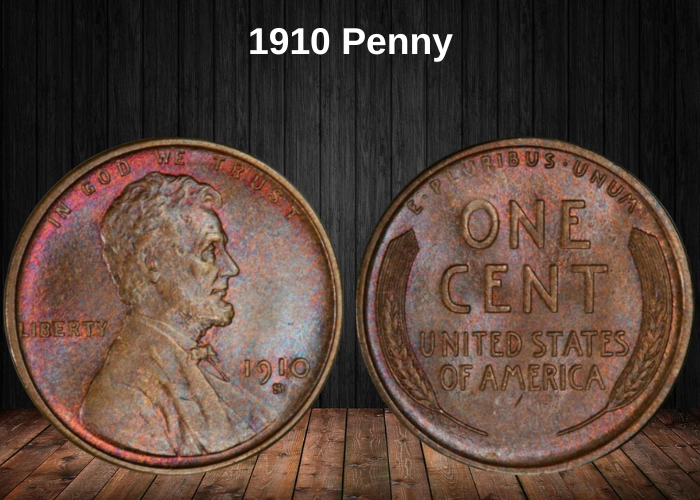
The Lincoln penny was introduced in 1909, making the 1910 mintage the second in this iconic coin series.
A Historic Change in U.S. Numismatics
Before the Lincoln cent, all U.S. coins featured the image of Lady Liberty on the obverse. However, in 1909, a decision was made to honor former President Abraham Lincoln to commemorate the 100th anniversary of his birth. This was a significant moment, as it marked the first time a real person appeared on a U.S. coin.
The reverse design also plays a key role in its identity. This cent is commonly known as the “Wheat Penny” due to the two stylized wheat ears framing the back of the coin. Over the years, the reverse design has changed several times, and today’s pennies feature a Union Shield instead.
The original designer, Victor David Brenner, had placed his initials on the reverse of the first 1909 pennies. However, this caused controversy, as some saw it as excessive self-promotion. As a result, the mint quickly removed the initials, and they remained absent on the 1910 pennies. It wasn’t until 1918 that Brenner’s initials were restored—this time, subtly placed on the obverse beneath Lincoln’s portrait, where they remain today.
Features of the 1910 Penny
The Obverse of the 1910 Penny
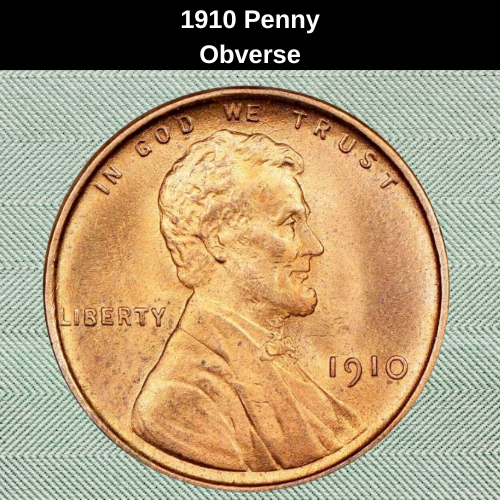
The 1910 Lincoln penny features a portrait of Abraham Lincoln on its obverse, a design that remains largely unchanged on modern cents. This image has endured longer than any other portrait in U.S. coinage history.
The Iconic Lincoln Portrait
This design was created by Victor David Brenner, a Lithuanian-born artist from a family of metalworkers. After emigrating to the United States, he later traveled to Paris to further his artistic studies. Upon returning to New York, he was commissioned to design the new Lincoln penny.
Brenner’s profile of Lincoln faces right and was inspired by various sources, including an unpublished photograph taken by Matthew Brady. The artist later stated that he imagined Lincoln in a moment of warmth—reading to a child—aiming to capture his liveliness and engaging nature.
Above the portrait, the familiar motto “IN GOD WE TRUST” follows the upper curve of the coin. The word “LIBERTY” appears to the left, while the date is positioned below on the right.
In 1910, pennies were minted at two U.S. facilities: Philadelphia and San Francisco. Philadelphia-minted coins do not bear a mint mark, while those from San Francisco have a small “S” beneath the date.
The Reverse of the 1910 Penny
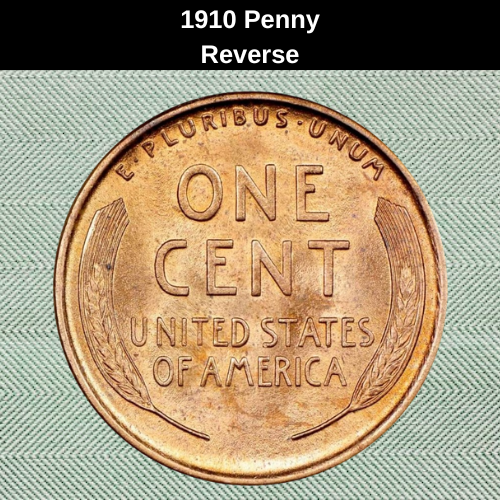
Victor David Brenner also designed the reverse of the first Lincoln pennies, which featured two ears of durum wheat. This design was used from 1909 to 1958, before being replaced in 1959 to commemorate the 150th anniversary of Lincoln’s birth. The new design showcased the Lincoln Memorial in Washington, D.C.
Interestingly, Brenner’s original concept for the reverse was quite different. He initially designed a tree branch, but this was rejected for being too similar to contemporary French coins. Given new instructions to create a simpler design, he returned with the wheat ears, which were ultimately approved.
The wheat stalks gracefully curve around the edges of the coin, framing the central inscriptions. Between them, the denomination “ONE CENT” is boldly displayed in large letters. Below, the country’s name, “UNITED STATES OF AMERICA”, appears in smaller font.
Above the denomination, the Latin motto “E PLURIBUS UNUM” follows the upper curve of the coin. This phrase, meaning “From the many, one,” symbolizes the unity of the states that formed the United States of America.
Other Features of the 1910 Penny
The 1910 penny is made from bronze, with a composition of 95% copper, and the remainder is a mix of tin and zinc. It has a weight of 3.11 grams and a diameter of 19 millimeters.
The coin’s color can vary depending on its handling and exposure to air. Coins with minimal handling often have a rich red shade, while those that have been more exposed to air or handled frequently turn brown.
Coin grading agencies categorize the color into three types:
- Red: At least 95% of the coin’s surface has a uniform red hue.
- Red and Brown: A mixture of red and brown shades on the coin.
- Brown: The entire coin is brown, without noticeable red coloring.
In general, red coins are valued more highly than red and brown coins, and red and brown coins are worth more than brown ones.
While certain Lincoln penny mintage years might see higher prices for red coins, the 1910 penny in any color can still be worth significantly more than its face value.
To learn more about grading the color of your Lincoln penny, you can check out a YouTube video from CoinOpp for helpful tips.
1910 Penny Grading
Here is a breakdown of the 1910 penny grading scale:
- Basal State-1: The coin is heavily worn, with most details completely missing.
- Fair: Only the most basic features are visible, with extensive wear.
- Very Fair: Slightly more detail remains visible, but the coin is still heavily worn. 4, 5, 6. Good: The coin shows some clear features, but there is significant wear. 7, 8, 10. Very Good: The coin’s design is mostly visible with some wear, but details are still noticeable. 12, 15. Fine: The coin shows moderate wear, but key design elements remain well defined. 20, 30. Very Fine: The coin has slight wear, with most of the design intact.
- Extremely Fine: The coin has only light wear, and the design is nearly complete.
- About Uncirculated: The coin shows only slight signs of wear, typically from handling.
- Mint State: The coin shows no wear and appears like it just came from the mint.
- Mint State (High): The coin is in near-perfect condition, with only the slightest imperfections.
- Mint State (Perfect): The coin is flawless, with no signs of wear or imperfections.
To determine the exact value of your 1910 penny, it’s essential to know its grade. Use this guide as a reference to assess the condition of your coin. If you’re unsure, consulting a professional grading service can help you get an accurate valuation.
1910 Penny Value Guides
1910 No Mint Mark Penny Value
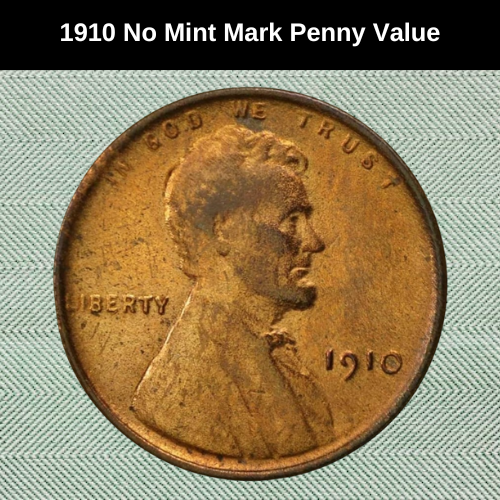
In 1910, the Philadelphia Mint struck nearly 147 million pennies due to high demand from banks. If you have a 1910 penny, you can identify whether it was minted in Philadelphia by checking the obverse: if there is no letter beneath the date, it was minted in Philadelphia.
The value of your penny depends on its condition and color. Coins are graded on a scale from 1 to 70, with 70 representing a perfect coin. Coins that have never been circulated are known as “mint state” (MS), and these are graded 60 and above.
Value of the 1910 Philadelphia Penny by Grade and Color:
- Brown Coins:
- XF45 (Extremely Fine): Worth about $5.
- MS60: Increases to $32.
- MS65 (Gem quality): Worth approximately $150.
- Red and Brown Coins:
- MS60: Valued at $32 (PCGS value might need updating).
- MS65: Slight premium over brown, around $160.
- MS66: Worth around $350.
- MS67: Top-grade red and brown coins are valued at $1,500 (only three certified at this level).
- Red Coins (Highest premium due to their color and condition):
- MS60: Starts at $50.
- MS65: Worth about $300.
- MS67: Increases to $2,250.
- MS67+: The finest examples, valued at $8,500 (24 certified at this level).
In summary, red coins are generally the most valuable, especially at MS67 or higher grades, and coins in mint state (never circulated) significantly increase in value as their grade improves. If you want to sell or appraise your coin, professional grading is essential to determine its true worth.
1910 S Penny Value
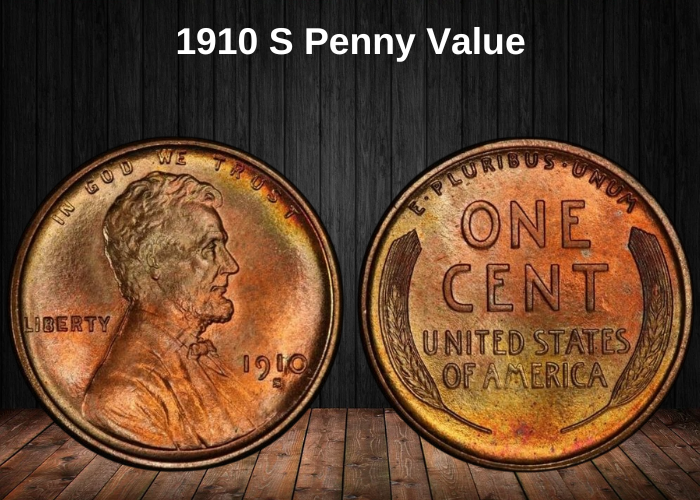
The 1910-S pennies, minted in San Francisco, have a much lower production rate, with only six million coins struck. This lower mintage typically means that coins with an “S” mint mark are more valuable than their Philadelphia counterparts at most grades.
Value of the 1910-S Penny by Grade and Color:
- Brown Coins:
- XF45: Worth approximately $60 (twelve times the value of a similar Philadelphia coin).
- MS60: Around $115.
- MS65: Certified by PCGS for about $400.
- MS65+: Only one known, with no public sales information, and the PCGS has not estimated its value.
- Red and Brown Coins:
- MS60: Valued at $125.
- MS67: At this grade, worth about $4,500.
- Red Coins (Most valuable):
- MS60: Estimated around $135 (likely a conservative estimate).
- MS67+: This coin can fetch up to an astonishing $55,000.
In short, 1910-S pennies, especially those in red or red and brown color, can command very high prices, particularly in the highest grades, like MS67+, where a red coin could be worth $55,000.
1910 (P) Proof Penny Value
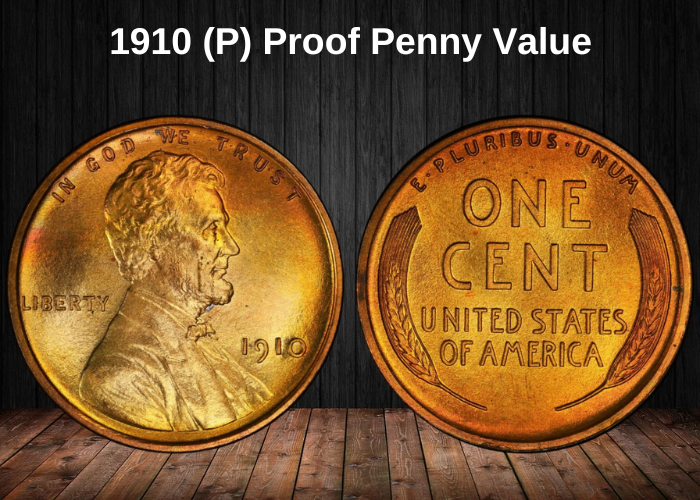
The 1910 Proof pennies were produced with special care using specially prepared planchets and dies. Unlike regular pennies, they were intended for coin archives and collectors, rather than for circulation. While modern proofs are made in large numbers, the 1910 proof mintage was much lower, with only 2,405 coins struck at the Philadelphia Mint.
Value of the 1910 Proof Penny by Grade and Color:
- Brown Proof Coins:
- MS60: Approximately $385.
- Red and Brown or Red Proof Coins:
- MS60: Around $425.
- Top Certified Brown Coins:
- MS67: Three coins have been certified at this level, each worth around $5,500.
- Top Certified Red and Brown Proof Coins:
- MS67: Five coins certified at this level, valued at $6,500 each.
- The Finest Known Red Proof Coin:
- MS68: Only one coin has been certified at this grade, with an astonishing value of $175,000.
Due to their rarity and high demand, 1910 proof pennies, especially the red ones and those in top grades like MS68, can be worth very significant amounts.
Rare 1910 Penny Errors List
1910 S/S Penny, Re-punched Mint Mark, FS-501
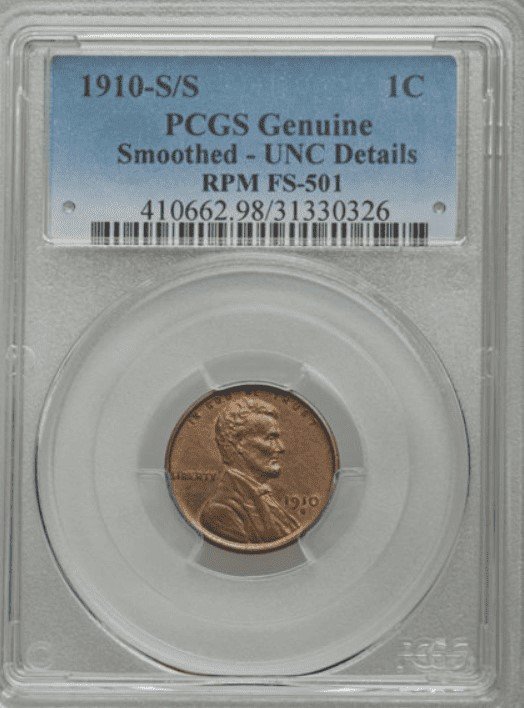
Some 1910 pennies struck in San Francisco feature two “S” mint marks. This is due to two different die varieties. The variety known as FS-501 has a faint S mint mark positioned just below a more prominent S.
FS-501 Die Variety Value Range:
- Brown Coin:
- Starting from $30 for coins graded at grade 4.
- At MS64, the value can rise to around $550.
- Red and Brown Coin:
- For coins graded MS60, the value begins at $285.
- At MS64, the price can reach as high as $2,200.
These double “S” mint marks significantly increase the coin’s value depending on its condition and color.
1910 S/S Penny, Re-punched Mint Mark, FS-502
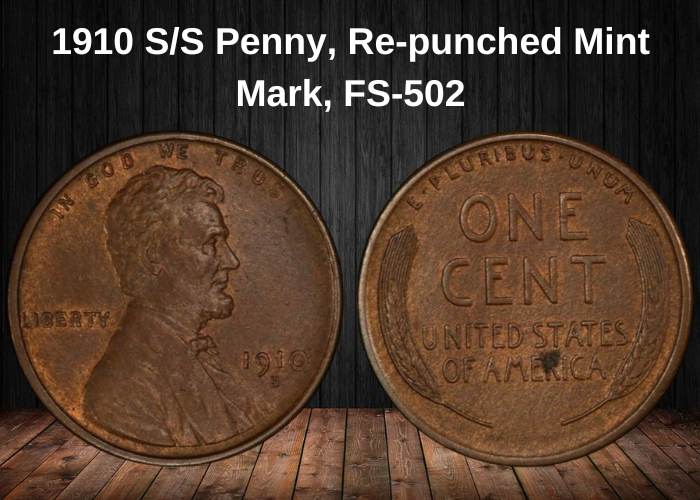
The FS-502 variety is another variation of the 1910 penny where the first, fainter S mint mark is struck slightly higher than the second one. While this variety is still valuable, the prices tend to be a little lower compared to the FS-501 variety.
FS-502 Die Variety Value Range:
- Brown Coin:
- Prices start at $28 (grade 4).
- At MS64, the value can rise to $425.
- Red and Brown Coin:
- For MS60, the value ranges from $225.
- At MS66, the value increases to around $1,400.
This error is also present on many red pennies, and their values start at $300 at MS60, with a rare example reaching as high as $20,000 at MS67.
You can find more about re-punched mint marks and how the condition affects the value of 1910 pennies in this YouTube video by Couch Collectibles.
FAQs
How much is a 1910 penny worth?
A 1910 penny can be worth much more than its face value, even in poor condition. Proof coins are particularly valuable, with prices starting in the hundreds of dollars. The condition, mint mark, and color of the coin will significantly affect its value. Even a one-point difference on the grading scale can cause a major change in price.
- S mint mark: Pennies with an S mint mark are generally more valuable than those without.
- Color: Red coins are typically more valuable than red and brown, which in turn are more valuable than brown.
- Mint errors: Errors like repunched mint marks can increase the coin’s value.
What is special about a 1910 penny?
The 1910 penny is special for several reasons:
- Historical significance: It was only the second year that the Lincoln penny was produced.
- First real person on US coins: It was the first US coin series to feature the image of a real person – Abraham Lincoln. All prior coins depicted legendary figures like Lady Liberty.
- Longest-running design: The portrait of Lincoln on the penny is the longest-running design in US coin history, remaining largely unchanged since its introduction.



















































